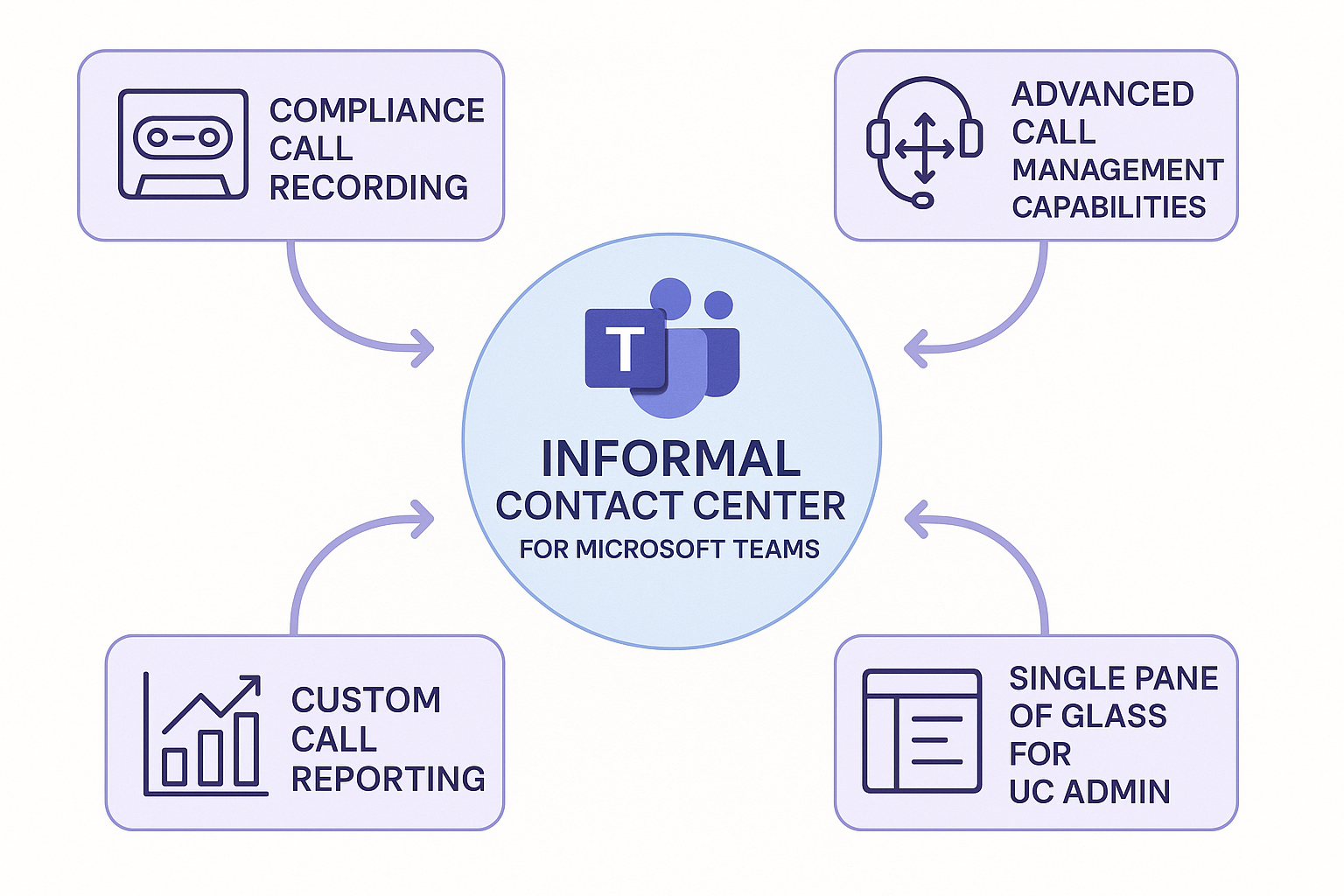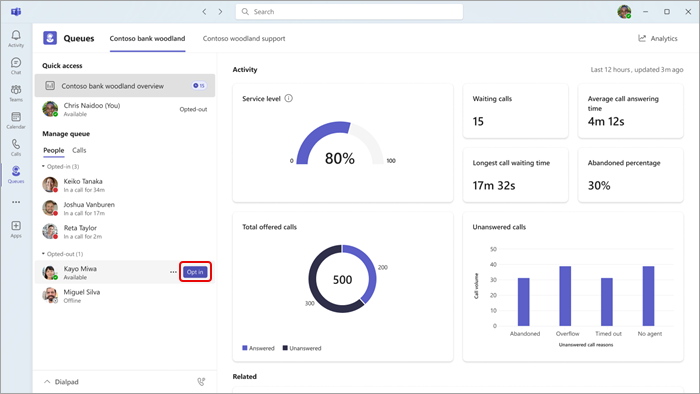Introducing The Informal Contact Center For Microsoft Teams

When you think of an informal contact center, what do you see?
Banks of desks answering calls? Maybe home workers being productive with headsets?
Or do you visualise the different technology components, extending the reach and use of Microsoft Teams?
When we talk about the informal contact center for Microsoft Teams, it means different things to different people. That’s why it’s informal.
What is an informal contact center?
Creating an informal contact center includes the provision of various peripheral and third-party technologies as well as manipulating existing features like auto attendants, queues, and even standalone web chat. You often see compliance call recording, advanced call management capabilities, and custom call reporting combined to create a DIY contact center.
If, for example, you want to bring helpdesk calls into Teams, need to unify all forms of internal communications, and want a single pane of glass for UC admin, there’s no need for a bells and whistles contact center solution. Instead, build your own or use an off-the-shelf informal model.

Does Microsoft Teams have a contact center?
Yes, Microsoft Teams does have a contact center. However, general feedback is that it falls in between requirements for basic call center requirements and fully-fledged omnichannel needs.
Yet, to turn Teams into the contact center most businesses need, it takes some work.
“We found it quite simple but effective - for us the main issue was tracking lost calls, but we added an external piece of software and it's working well enough. As a pure CC platform it's kind of weak, but in the bigger context, it's a win not having to maintain one (or - worse - two) separate PBXs.”KaWatah on r/MicrosoftTeams.
Often, you might start with the Queues app and still need extra functionality. But the jump up is going all-in on Dynamics 365 Contact Center. This means increasing your spending from Teams Phone with the Queues app to $95 per user (or $110 to add digital channels outside of just voice).

And let’s be honest. If you had deemed you were ready for omnichannel with email, web chat, social media, etc., you’d have already taken the leap by now.
“Dynamics 365 Contact Center would be too elaborate/expensive for our use case.”
Hasepin on r/MicrosoftTeams.
- The question isn’t: Am I ready for omnichannel?
- It’s: Where’s the middle ground between Queues and omnichannel?
There is, of course, the option to use a third-party, certified contact center for Microsoft Teams. These businesses all provide good software in their own right. However, they again are omnichannel by design and come with similar price points.
Hence, a gap in the market for the informal contact center for Microsoft Teams.
The benefits of an informal contact center for Microsoft Teams
The major benefit of using an informal contact center for Microsoft Teams is that you don’t have to invest in an expensive omnichannel solution.
While the likes of Five9, Genesys, and 8x8 are certified contact center solutions for Microsoft Teams, they are overkill for many businesses.
Instead, opting for an informal model means you can either construct your own add-on services (call recording, reporting, advanced queues, etc.) or select a provider that sits in between native Teams functionality (basic queues, auto attendant, limited metrics) and omnichannel providers.
When taking this route, you open the door to a wealth of benefits:
- Improved call handling
- Better customer experience
- Considerable cost savings
- Unlimited scalability
- Streamlined administration
Your 3 options for informal contact center for Microsoft Teams
If you subscribe to Teams Phone via Microsoft directly.
You’re restricted to native Teams calling functionality. Here, you can use Teams call queues and other built in functionality:
- Call Routing: Attendant, serial, round robin, longest idle
- Call greeting and music: custom greeting message, music on hold, multilingual support
- Agent management: Assignment, opt-in/out functionality, channel integration
- Advanced features: Presence-based routing, call prioritisation, queue callback
- Basic reporting: Limited to calls waiting, wait times, and very few advanced analytics
If you subscribe to Teams Phone via a partner or MSP.
The alternative is to approach a provider of supplementary services (call recording, analytics, CRM integration, etc.) and see what they bolt on.
The issue here, however, is that these providers cater to service providers. As such, they don’t have a direct product available for consumer purchase. Instead, their business model is to sell to managed service providers (MSP). In line with this, your route to these features will likely come with a packaged deal that includes professional services, support, and supplementary services.
It’s rare to find an MSP that will sell you a single service. It’s not their business model and could end up losing them money in the long term. This isn’t a negative on their part. It’s just business.
Certified Microsoft Teams contact centre solutions
Standalone solutions exist to plug the gap between native Teams functionality and omnichannel software.
Here, you have the choice between an overlay solution (like Heedify) that integrates with Teams Phone and Azure Communications Services or standing up multiple vendors of call recording, analytics, CRM integration, etc.
If you’re looking for a single supplementary service, it may be best to approach a call recording vendor only. For example, if you’re happy with the Teams Phone functionality for handling inbound calls and just need to take PCI-compliant payments, there’s little need to dabble further.
However, if you’re looking to turn Teams into an informal contact center, you’re much better off procuring something ready to go out-of-the-box.
How to use Heedify as your informal contact center for Microsoft Teams
Heedify is your Microsoft Teams contact center companion. We turn Microsoft Teams into a fully-fledged contact center without the need for expensive omnichannel investment.
Companies like NHS Royal Marsden and Cerfrance use Heedify to streamline call flow management and optimize processes in real time.
Our goal is to enable you to provide your customers with the experience they crave while increasing your return on investment into Teams. That way, both parties benefit.
Heedify integrates with Teams Phone and Azure Communications Services and takes less than 60 mins to set up.
With advanced call management features like queues, IVR, and call recording, you can reduce wait time and introduce self-service without the need to go all-in on omnichannel contact center software.
With Heedify, you get access to:
- Smart call queuing
- Skills-based routing
- Interactive voice response (IVR)
- Automatic call distribution
- Real-time queue dashboards
- PowerBI call analytics

You also extend the reach of Teams call reporting. By integrating with PowerBI, Heedify provides analytics capabilities, like:
- Live wallboards
- Real-time queue management
- Historical KPIs like first call resolution and average handle time
- Agent status and performance
- Wait/resolution/abandon times

These are all available out-of-the-box and ready to customise as you see fit.
Use more than Teams day to day?
Heedify also integrates with CRMs like HubSpot, Salesforce, and ServiceNow. So, no matter what’s in your tech stack, you can create a fully integrated, high-functionality informal contact center for Microsoft Teams without expensive omnichannel investment.
Want to see Heedify for yourself?

Speech Analytics in Call Centers: How AI Is Revolutionizing Customer Experience
Discover how AI and Heedify revolutionize speech analytics to enhance customer experience in call centres.

How Agentic AI transforms Contact Centres in 2026
Discover how Agentic AI is transforming contact centres in 2026. Learn how enhances agent performance, and delivers predictive, personalized experienc

Microsoft Teams Phone Extensibility: Superior Attendant Console with Heedify
Découvrez Unify, la solution certifiée pour Microsoft Teams. Éliminez la double sonnerie et simplifiez vos communications avec Heedify.
